-
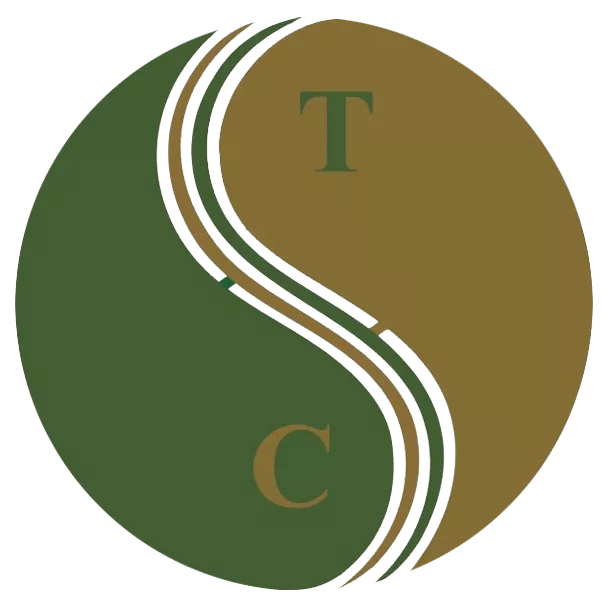 Art of Wellness Acupuncture & Traditional Chinese Medicine (TCM)11704 Wilshire Blvd, Suite 295, Los Angeles, CA, 90025
Art of Wellness Acupuncture & Traditional Chinese Medicine (TCM)11704 Wilshire Blvd, Suite 295, Los Angeles, CA, 90025
myartofwellness@gmail.com310-451-5522 Office Hours
MonClosedTue7:30 am --4 pmWed7:30 am --4 pmThu7:30 am -- 4 pmFri7:30 am -- 4 pmSat7:30 am -- 4 pmSunClosedOur office opens from Tuesdays to Saturdays 7:30 am to 4 pm, will be closed on Memorial day, Independent day, Labor day, Thanksgiving day, Christmas and New year.
-
Recent Posts
- How to Treat Rosacea With Acupuncture and TCM
- How to Treat Perioral Dermatitis With Acupuncture and TCM
- Lymphatic Drainage With Acupuncture and TCM
- How to Treat Turf Toe With Acupuncture
- How to Treat Nerve Pain With Acupuncture and TCM
- How to Treat Watery Eyes With Acupuncture and TCM
- How to Treat Ovarian Cysts With Acupuncture and TCM
- How to Treat Dystonia With Acupuncture and TCM
- Can Acupuncture Help Bad Breath?
- How to Treat Atopy with Acupuncture and TCM
- Plantar Fasciosis Treatment With Acupuncture and TCM
- How to Protect Yourself When Air Quality Is Poor
- How to Treat Spinal Headache With Acupuncture and TCM
- How to Treat Sarcoidosis With Acupuncture and TCM
- How to Treat Flu With Acupuncture and TCM
- Chinese New Year 2025 Year of the Snake
- Sign up to receive news and updates and get my free report:“The Top 10 Reasons to Try Acupuncture”

July 2025 M T W T F S S 1 2 3 4 5 6 7 8 9 10 11 12 13 14 15 16 17 18 19 20 21 22 23 24 25 26 27 28 29 30 31
Neurological Conditions
How to Treat Encephalitis With Acupuncture and TCM
By Xiaomei Cai, L.Ac., Ph.D. & Qineng Tan, L.Ac., Ph.D.
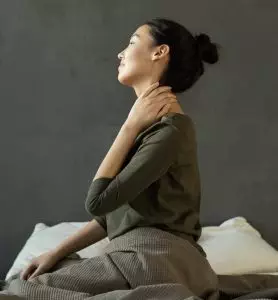
Headache, sensitivity to light, stiff neck, short-term memory loss? These could be signs of encephalitis, or inflammation in the brain. Infectious encephalitis can happen due to an infection; autoimmune encephalitis (AIE) is a type of autoimmune disorder. Acupuncture and TCM offer an adjunct treatment for encephalitis recovery.
What is encephalitis? Encephalitis refers to a serious condition in which the tissues of the brain become inflamed. It can happen to anyone, but is more common among children and older people.
The symptoms of encephalitis are sometimes ignored, because headaches, neck pain, and “brain fog” are so common and may not seem that serious at first. However, in combination, these signs should not be taken lightly. Like meningitis (inflammation of the membrane surrounding the brain and spinal cord), encephalitis can cause serious complications if left untreated. Encephalitis needs to be caught early and treated in order for people to make a full recovery.
What causes encephalitis? Brain inflammation can be caused by the body’s immune response to an infection, or due to an autoimmune disorder, in which the body produces antibodies that attack the brain tissues.
Top 10 Causes of Encephalitis
Viral infections are the primary reason that people develop encephalitis. These could be viruses carried by insects, especially mosquitoes, which are then contracted by humans through bites. Other communicable viral infections that pass from person to person through bodily fluids or close contact can also cause infectious encephalitis.
Infections that can lead to encephalitis include:
- Mosquito-borne viruses such as: West Nile Virus, Eastern Equine encephalitis, Western Equine encephalitis, St. Louis encephalitis, LaCrosse encephalitis
- Tick-borne viruses
- Rabies virus – can be contracted through being bitten by an infected animal
- Polio virus
- Herpes Simplex, Type 1 and Type 2 (HPV1 and HPV2)
- Epstein-Barr virus (mono, mononucleosis)
- Varicella Oster virus (chicken pox, shingles)
- Measles (rubeola)
- German measles (rubella)
- Mumps
There have been cases of people developing encephalitis as a complication of a COVID-19 infection.
Some cases of encephalitis can be caused by bacterial or fungal infections, or by a parasite. It could also be caused by exposure to some sort of allergen or toxin in the environment.
People with weakened immune systems—for example, due to HIV/AIDs—or who take immunosuppressant medications are at a higher risk for developing encephalitis.
Immunotherapy used to treat certain kinds of cancer, such as melanoma, ovarian cancer or lung cancer, has been shown to cause encephalitis in some cases.
Some cases of autoimmune encephalitis, called Anti-NMDAR encephalitis, appear to be related to a certain kind of tumor called a teteroma. In women and young women, especially, this can be an ovarian tumor that produces the antibodies for NMDAR.
Symptoms of Encephalitis
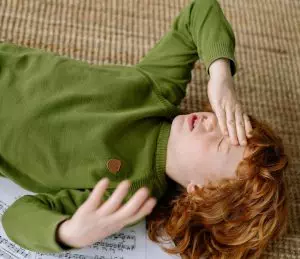
A mild case of encephalitis might only cause some flu-like symptoms that clear up within a few weeks. These types of symptoms include:
- Headache
- Stiff neck, neck pain
- Muscle aches, joint pain
- Fever
- Fatigue, feeling tired and weak
- Sensitivity to light
More severe symptoms of encephalitis can affect both cognitive and motor function:
- Mental confusion, brain fog, difficulty concentrating
- Memory problems, short term memory loss
- Hallucinations
- Seizures
- Severe headache
- Trouble with coordination or balance
- Loss of sensations in parts of the body or face
- Loss of muscle control in parts of the body or face
- Problems with speaking or hearing
- Mood swings, changes in personality
Anti-NMDAR encephalitis (when there may be an ovarian tumor involved, especially) can cause symptoms like pro-domal headache, nausea, and fever, which may then progress to more severe complications, including involuntary movements or tremors, urinary incontinence, rapid heartbeat, and psychiatric symptoms like anxiety, paranoia, or mania.
In severe cases, encephalitis can cause loss of consciousness and even cause a person to go into a coma. It is very important to seek urgent medical attention if you experience any of these symptoms.
Treatment for Encephalitis

Blood tests can confirm whether a viral or bacterial infection is causing encephalitis. Imaging tests like an MRI or CT scan may show the inflammation in the brain. A spinal tap may show an imbalance in cerebral fluids, or an EEG may show unusual electrical impulses in the brain.
However, there are times when these tests will not show exactly what is causing the encephalitis. As with many autoimmune disorders, it can be hard to pinpoint a clear diagnosis for autoimmune encephalitis (AIE).
Medical treatment for encephalitis will depend on what type it is determined to be. Mild inflammation will usually be treated with over the counter anti-inflammatory medications. Antivirals or antibiotics will be prescribed if a specific infection is found to be the cause. Steroids will often be used to help reduce inflammation. In more serious cases, a person may require breathing assistance or anti-seizure medications.
In cases where the cause is believed to be an autoimmune response, immunotherapy is used to try to interfere with the antibodies that are attacking the brain tissues. Steroids will be usually used in combination with other treatments. Plasmapheresis, or plasma exchange, removes some of these antibodies from the blood. Intravenous immunoglobulin therapy introduces healthy antibodies to block the action of the malfunctioning antibodies.
In cases of anti-NMDAR encephalitis where a tumor is present, treatment will include the removal of the tumor in addition to immunotherapy. Patients with this type of encephalitis may also be prescribed antipsychotic drugs to relieve psychiatric symptoms.
Immunotherapy works for some patients, but not all. Many patients will be offered second-line treatments such as monoclonal antibodies or antimetabolites. In some cases, people may seem to recover from encephalitis for a while, and then have a relapse in which the inflammation flares up again.
Most people will need significant time and rehabilitation to help them make a full recovery from encephalitis. Some people will have long-lasting effects, such as memory problems, balance and coordination issues, speech problems, and emotional volatility.
Many of the pharmaceutical treatments available for encephalitis cause significant side effects and can even lead to more physical, emotional and mental health issues. Fortunately, acupuncture and other TCM modalities offer a way to reduce inflammation in the brain and help relieve encephalitis, as well as helping to offset any side effects from other medical interventions.
Can Acupuncture Help Encephalitis?

With acupuncture and Chinese herbs, we seek to treat the root cause and the various symptoms and complications of each condition according to recognizable patterns. This allows us to effectively treat some conditions, such as autoimmune diseases, neurological disorders, and inflammatory conditions that may not readily respond to conventional medicine.
In the TCM view, inflammation occurs because there is too much heat in the body. Yang energy provides the “fire” we need to keep the body warm and energetic. But, if there is an imbalance, and too much heat, this leads to conditions like fever, infections, and inflammation. So, we see pathogenic internal heat as contributing to encephalitis, in addition to outside pathogens like viruses or bacteria. To clear heat that is trapped or stagnant in the body, we will use specific herbs and cooling foods, along with acupuncture treatment and lifestyle changes to reduce physical and mental stress. TCM herbs can also be highly effective against bacterial and viral infections.
The motor control and cognitive problems that can result from encephalitis occur because the inflammation in the brain is affecting the functioning of the central nervous system. With acupuncture, we can help to reestablish connections and neural pathways.
Autoimmune disorders are still not well understood by Western medicine, but with acupuncture we can help to balance and regulate the immune system, so that it is not being inappropriately triggered. This is why acupuncture works well as an adjunct treatment for encephalitis and many other autoimmune disorders.
Acupuncture Near Me for Encephalitis in Los Angeles and West Los Angeles
It can be very difficult when you or someone you love is facing a serious illness and a long, difficult recovery. TCM offers a healthcare option that treats each person in a highly individualized and caring way. At Art of Wellness, we have over 30 years of experience helping people gain back their strength and mobility after suffering from conditions like encephalitis, meningitis, Lyme disease, Guillain Barré Syndrome, Myasthenia Gravis, and many others.
*This article is for education from the perspective of Traditional Chinese Medicine only. The education provided by this article is not approved by FDA to diagnose, prevent, treat and cure human diseases. It should not stop you from consulting with your physician for your medical conditions. Traditional Chinese Medicine is based on Qi, which is an invisible force that usually cannot be observed by modern science. Because science focuses on testing ideas about the natural world with evidence obtained through observation, these aspects of acupuncture can’t be studied by science. Therefore acupuncture and Chinese herbs are often not supported by double-blind, randomized trials, and they are considered alternative medicine therapies in the United States.
How to Treat Occipital Neuralgia With Acupuncture and TCM
By Qineng Tan, L.Ac., Ph.D. & Xiaomei Cai, L.Ac., Ph.D.

Throbbing headache and back of neck pain? Occipital Neuralgia, sometimes called “occipital migraine,” is a kind of chronic headache that causes stabbing neck pain and headache back of head. Acupuncture and TCM offer a way to help ease occipital nerve pain.
Occipital headache causes are usually due to compression of the occipital nerves, which start at the top of the spine where the neck is joined to the head and then run up into the scalp. A pinched nerve in the neck area, or tight muscles in the neck can lead to occipital pain, like a headache at base of skull.
Neck pain and back of head pain from an occipital migraine is often described as feeling like an electric shock or “zap,” or a sharp, shooting pain in the back of the head. The sensation may come on suddenly and last for only a few seconds, or it can go on throbbing for hours.
Occipital neuralgia pain is similar to that of Trigeminal Neuralgia, in which the intense nerve pain is on one side of the face, rather than the back part of the head. Occipital pain can also resemble that of chronic migraines and other kinds of headache disorders.
Occipital Neuralgia pain areas can include:
- Pain starts in the back of the neck and spreads upwards
- Back of head pain, behind the ears
- Pain on one side of the head
- Scalp pain, scalp tender to the touch
- Pain in the forehead
- Pain behind the eyes
- Eyes are sensitive to light
Occipital neuralgia pain can make the scalp feel so sensitive that even shampooing your hair or resting your head on a pillow feels unbearable. It can also feel like a burning sensation, or simply an aching neck.
Acupuncture can be used as an alternative or adjunct therapy for occipital neuralgia to bring headache and neck pain relief.
What Causes Occipital Neuralgia?
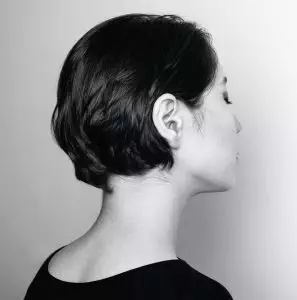
Occipital neuralgia occurs when the occipital nerves in the back of the head and neck are irritated or injured. There can be many different kinds of factors that trigger occipital neuralgia, such as:
- Pinched nerve in the neck
- Tension or tight muscles in the neck cause compression
- Compression of the nerves due to osteoarthritis in the spine, degenerative disc disease, or a herniated disk
- Trauma to the back of the head or the neck
- Tumor or other type of lesion in neck compresses the nerves
- Gout
- Diabetes
- Vasculitis (inflamed blood vessels)
Holding the head and neck in a position where it is tilted forward and down, such as when reading or looking at a screen for long periods of time can be associated with occipital neuralgia.
Often, though, the exact cause of the occipital pain in the head and neck is not discovered.
There is no clear test used to diagnose occipital neuralgia. The symptoms of occipital nerve pain are similar to other types of migraine headaches, and it is possible for a person to have both migraines and occipital neuralgia, so it can be challenging for doctors to determine exactly what is going on.
Conventional Treatment for Occipital Neuralgia
One of the ways that medical doctors will try to confirm a diagnosis of Occipital Neuralgia is by injecting a combination of anesthetic and steroids (occipital nerve block) into the affected area, to see if it deadens the pain. Botox injections can also be used to produce this effect. The hope is that the irritated nerve will heal over time.
If neck tension seems to be the issue, muscle relaxants may be prescribed. Massage therapy can sometimes be helpful in these cases.
Occipital neuralgia treatment at home might involve alternating ice packs and heating pads to help relieve pain at the back of the neck. Exercises like yoga may also be helpful for relieving neck tension that triggers the nerve pain.
If none of these treatments provides relief, then surgical options might include occipital nerve stimulation, in which electrodes are implanted to block nerve signals.
Acupuncture and TCM can be sought as an alternative way to deal with occipital neuralgia, and many other types of nerve pain.
Can Acupuncture Help Occipital Neuralgia?

From the TCM point of view, pain conditions that come and go, or cause periodic pain and stiffness, fall under a category called “Bi Syndromes.” “Bi” means “obstruction.” Bi Syndromes occur when an external pathogenic force like wind, cold, or dampness gets into an area of the body and causes blockages in the flow of Qi. Then, the muscles and joints may be tender, swollen, or sore, or numb and tingling, or have limited range of movement. Most types of arthritis, for example, are Bi Syndromes, according to TCM theory.
Occipital neuralgia is considered a Bi Syndrome, where tightness in the neck and base of the skull causes the stabbing nerve pain to flare up. The goals of acupuncture treatment for occipital headache and neck pain are to reduce tension, stress, and inflammation, to clear blockages in the Qi at the organ system level, and to provide natural analgesic relief from nerve pain signals.
One case study of a patient who had been suffering from occipital headaches for over a year found that her pain resolved after five acupuncture treatments.
A systematic review of evidence related to TCM treatment for occipital neuralgia in China showed that acupuncture was effective both as an alternative to medical treatment, and as an adjunct to medicine.
Acupuncture Near Me for Occipital Neuralgia in Los Angeles
At Art of Wellness Acupuncture near Santa Monica and Brentwood, we have over 30 years of experience helping people heal from all kinds of neurological conditions and nerve pain. Conditions related to nerve compression, such as Carpal Tunnel syndrome (wrist pain), Morton’s Neuroma (ball of foot pain), Sciatica (hip pain), Plantar Fasciitis (heel pain), and even dental pain (toothaches) can all be relieved with acupuncture and TCM treatment. If you or someone you know is suffering with recurring headaches, migraines, or neck pain, please consider giving acupuncture a try.
*This article is for education from the perspective of Traditional Chinese Medicine only. The education provided by this article is not approved by FDA to diagnose, prevent, treat and cure human diseases. It should not stop you from consulting with your physician for your medical conditions. Traditional Chinese Medicine is based on Qi, which is an invisible force that usually cannot be observed by modern science. Because science focuses on testing ideas about the natural world with evidence obtained through observation, these aspects of acupuncture can’t be studied by science. Therefore acupuncture and Chinese herbs are often not supported by double-blind, randomized trials, and they are considered alternative medicine therapies in the United States.
How to Treat Morton’s Neuroma With Acupuncture and TCM
By Qineng Tan, L.Ac., Ph.D. & Xiaomei Cai, L.Ac., Ph.D.

Do you feel like there is a pebble in your shoe all the time? Burning, tingling ball of foot pain? Tenderness between the 3rd and 4th toes? These could be symptoms of Morton’s Neuroma, a condition in which inflammation and swelling around a nerve in the ball of the foot causes toe pain and numbness. Acupuncture and Chinese medicine can help relieve Morton’s Neuroma foot pain.
Morton’s Neuroma is a problem related to swelling and thickening of tissue around a nerve in the foot. This nerve runs under the ligaments that connect the toe bones to the bones of the foot. A neuroma is considered to be a kind of benign tumor or growth and is usually not large enough to feel as an actual lump on the bottom of the foot.
Pain in the forefoot, or ball of foot pain, can be a sign of Morton’s Neuroma, or it could be a symptom of one of several other conditions, including:
- Metatarsalgia – a general term for pain and inflammation in the ball of foot, around the metatarsals. Pain symptoms can be similar to those of Morton’s Neuroma
- Capsulitis – irritation of the capsular ligaments in the foot can cause pain in the ball of the foot that comes and goes
- Gout – a type of arthritis in the foot or toes, caused by a buildup of uric acid
- Rheumatoid Arthritis (RA) – an autoimmune condition that causes arthritic pain that usually begins in the extremities
- Bunion pain – a bony bump that develops on the outside of the big toe joint
- Edema – swelling caused by fluid trapped in the tissues of the foot
- Arthritis – a general term for joint pain, which can affect the toes and feet
- Fractured bones in foot
- Bursitis – bursas are small sacs that act as cushioning for joints; there are bursae around the metatarsals that can become inflamed, causing ball of foot pain
- Tarsal Tunnel Syndrome – a condition where the tibial nerve is compressed in the tarsal tunnel area of the ankle, causing pain and tingling in the foot
- Radiculopathy – compression of a nerve in the lower back can cause pain in the foot, similar to sciatica
- Hammertoe – when one of the toes becomes bent, usually due to pinching shoes, and the muscles and ligaments can’t straighten it, causing swelling and pain
- Diabetes – foot pain and numbness (diabetic neuropathy) can happen due to diabetes.
It is possible for a person to have one of the conditions listed above, and also have a Morton’s Neuroma; sometimes another foot problem can contribute to the development of a neuroma.
Morton’s Neuroma Symptoms
The signs of a Morton’s Neuroma include:
- Ball of foot pain, especially when you put weight on in
- Toe pain or pain between the toes
- Numbness or tingling in the ball of the foot, “pins and needles” sensation
- Swelling between toes or in the ball of the foot
- Pain is better with rest, staying off of your foot
People often describe the sensation as feeling like there’s a pebble in your shoe or a wrinkle in your sock that is irritating, particularly in the area between the third and fourth toes.
Typically, the symptoms of neuroma begin to be noticeable when you are either engaging in an activity that aggravates the nerve, like running or playing a high-impact sport like tennis, or wearing shoes that force the ball of your foot to take extra impact. The pain and tingling may get better when you finish, take off your shoes, and rub your foot.
Over time, though, as the neuroma gets bigger, the pain may get worse and more persistent. If Morton’s Neuroma is left untreated, it can cause permanent damage to the nerve.
What Causes Morton’s Neuroma?

Morton’s Neuroma occurs due to compression of the nerve in the foot that carries sensory signals from the toes. Some people may be more prone to developing Morton’s Neuroma due to the shape of their foot, such as having an unusually high arch, or a very flat foot.
The way that the foot hits the ground and leaves the ground while walking or running can cause a lot of impact and stress to the ball of the foot. An injury to the foot or toes, or other type of trauma, can trigger this nerve condition, as can repetitive stress from a particular sport or other activity. Wearing high heels, flip-flops, or shoes that pinch the toes together can be a factor.
Morton’s Neuroma Treatment
A foot specialist, or podiatrist, will diagnose Morton’s Neuroma by feeling the ball of the foot to see if there is a noticeable mass and to sense what the pain and tingling symptoms are like for the patient. An ultrasound or MRI can show a soft tissue mass like a neuroma, and may be used to confirm the diagnosis.
Usually the first recommendations for a person with Morton’s Neuroma will be to change their footwear: choosing roomier shoes and softer, padded socks, etc. Orthotic supports may be prescribed.
Steroid injections may be used to relieve pain and swelling. If these measures do not help, surgery for Morton’s Neuroma can either be to cut ligaments and other nearby tissues to try to relieve pressure, or in some cases, the affected nerve itself may be removed (neurectomy). This can relieve pain; it can also reduce sensation in the foot permanently. There is also a chance with some surgeries that the neuroma may simply grow again.
Neuromas do not generally go away on their own. The most conservative treatment options for Morton’s Neuroma—like rest, icing, and different shoes—may or may not help to relieve the pain and tingling. Fortunately, acupuncture treatment is an excellent way to help relieve nerve pain.
Can Acupuncture Help Morton’s Neuroma Foot Pain?
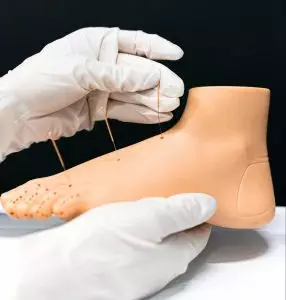
Inflammation and compression around nerves can cause nerve pain in many different parts of the body. For example, pinched or compressed nerves in the spine, or a herniated disc, can cause sciatica or piriformis syndrome: hip pain or pain that radiates down the leg. Compression of the plantar nerve can cause heel pain. A pinched nerve in the neck can cause shoulder pain and/or neck pain. Impingement of the median nerve causes carpal tunnel syndrome. An inflamed trigeminal nerve causes pain in the face. With acupuncture, we are able to provide treatments that can help relieve all of these types of nerve pain.
Acupuncture and other Chinese medicine modalities can help to reduce inflammation that presses on nerves, release scar tissue, and help to heal nerves and the irritated soft tissues surrounding them, like ligaments and muscles. Acupuncture also acts as an analgesic, reducing pain and increasing endorphins.
Evidence suggests that the stimulation of acupuncture points encourages the pituitary gland to release more cortisol, which plays an important role in reducing inflammation. It has been hypothesized that acupuncture influences the release of neuropeptides from nerve endings, which is also a key part of the inflammatory response.
According to TCM theory, this type of pain is often considered to arise due to “Bi Syndrome” conditions, in which stagnation of Qi and blood causes stiffness. The blockage of energy usually occurs due to pathogenic forces of “wind,” “cold,” or “dampness,” or some combination of these factors. Thus, the acupuncture practitioner will choose from a variety of methods including acupuncture, herbal supplements, moxibustion, and Tuina massage to clear obstructions that lead to pain and numbness, such as with Morton’s Neuroma.
Acupuncture Near Me for Morton’s Neuroma, Los Angeles Area
There are many different conditions that can cause foot pain and toe pain. It is important to seek care for foot problems promptly, so that they do not become worse. Acupuncture and other TCM treatments can help improve and maintain foot health for everyone, and can help manage and relieve many types of injury or disorders that affect the feet. At Art of Wellness near Santa Monica, we have 30 years of experience helping people stay active and on their toes.
*This article is for education from the perspective of Traditional Chinese Medicine only. The education provided by this article is not approved by FDA to diagnose, prevent, treat and cure human diseases. It should not stop you from consulting with your physician for your medical conditions. Traditional Chinese Medicine is based on Qi, which is an invisible force that usually cannot be observed by modern science. Because science focuses on testing ideas about the natural world with evidence obtained through observation, these aspects of acupuncture can’t be studied by science. Therefore acupuncture and Chinese herbs are often not supported by double-blind, randomized trials, and they are considered alternative medicine therapies in the United States.
How to Treat Ataxia With Acupuncture and TCM
By Qineng Tan, L.Ac., Ph.D. & Xiaomei Cai, L.Ac., Ph.D.

Ataxia is a general term that covers many conditions involving muscle weakness or lack of coordination. Ataxia causes can include: infections, neurological disorders, degenerative brain disease or tumors, some autoimmune disorders, stroke, or alcohol addiction. Acupuncture can help with the muscular weakness and balance problems of cerebellar ataxia and sensory ataxia.
Ataxia can affect the limbs, leading to difficulty with balance and walking. It can also affect the muscles involved in speech, chewing and swallowing, and eye movements.
Different types of Ataxia include:
- Cerebellar ataxia – The most common types of ataxia are related to some sort of problem with the cerebellum, the part of the brain in the back of the head, which regulates muscle activity, balance, and equilibrium. Damage or dysfunction of the cerebellum can also cause tremors and difficulty in judging distance (dysmetria).
- Sensory ataxia – Ataxia may also happen due to issues with other parts of the brain and nervous system, such as damage to the somatosensory nerve, the brain stem, posterior lobe, cerebral cortex, the spinal cord, or the peripheral nerve. These kinds of ataxia can affect the gait and walking.
- Vestibular ataxia – Inner ear problems can cause ataxia that affects balance and can cause vertigo, dizziness, nausea.
- Hereditary ataxias – While they are rare, some people are born with hereditary forms of ataxia. These are classified as autosomal dominant or autosomal recessive, and they may begin to show up at any point in life. These types of ataxia are usually degenerative, meaning the symptoms are chronic and get worse over time. Autosomal dominant ataxias used to be called “Marie’s ataxia,“ and autosomal recessive ataxias used to be called “Friedrich’s ataxia.”
Ataxia may be acute or chronic, with symptoms that last for hours, days, weeks, or years, depending on the root cause. An infection, for example, could cause a temporary episode of ataxia. Ataxia can be triggered by an autoimmune flare-up.
Acupuncture and other TCM modalities are uniquely helpful for all kinds of neurological problems, including ataxia symptoms. Acupuncture can help to restore communications between parts of the nervous system and repair damaged nerve cells.
Top 10 Causes of Ataxia:
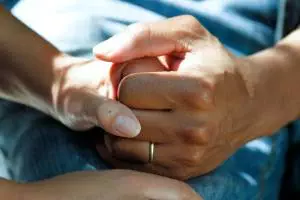
Ataxia can be caused by a wide variety of health issues that affect the brain and nervous system:
- Stroke, brain aneurysm
- Brain tumor or lesions on the spinal cord
- Alcohol abuse
- Some medications or chemotherapy
- Toxins, heavy metal poisoning
- Severe vitamin deficiency
- Hypothyroidism, hyperthyroidism, thyroid problems
- Multiple Sclerosis
- Celiac Disease
- Encephalomyelitis (Chronic fatigue syndrome, ME/CFS)
Ataxia can also result from serious infections like Lyme disease, Chickenpox, HIV, or COVID-19.
The severity and duration of ataxia symptoms can vary, depending on the cause of ataxia, and the type.
Medical Diagnosis and Treatment for Ataxia
It can be challenging to get a clear diagnosis when a person shows symptoms of Ataxia. Testing for Ataxia often involves performing the Romberg Test. This is a fairly simple, physical test, often used by both doctors to measure a person’s balance and coordination. It is sometimes used by police officers to determine if someone is under the influence of alcohol.
The patient undergoing examination stands in various positions, closing and opening the eyes, and shaking the head from side to side. The changes in their ability to balance and maintain their position can help a doctor quantify their equilibrium in order to diagnose sensory ataxia, or vestibular ataxia, for instance. It can also help determine if a patient suffers from vertigo.
Other physical testing involves studying a person’s gait, or mode of walking. A person with sensory ataxia, for example, often demonstrates a particularly heavy, high-stepping gait due to the lack of sensation of the bottoms of their feet when they touch the ground.
Blood tests, spinal tap testing, or MRI imaging may show if ataxia is due to some sort of damage to the brain or spinal cord, or if there are lesions, tumors, or possibly some sort of infection causing the problem.
For most ataxia symptoms, however, there is no specific medical treatment. Patients who are having trouble with walking or moving their hands and facial muscles, may be referred to physical therapy or occupational therapy. Some people will need walkers or other physical aids.
Acupuncture offers a way to help people with all kinds of ataxia to improve their muscle coordination, balance, and other problems.
Can Acupuncture Help Ataxia?

Acupuncture treatment and other TCM modalities are suited to helping patients with all kinds of neurological conditions, by enhancing connections between the brain and the nervous system, and helping to restore the healthy development of nerve and neural cells. For patients with ataxia, this means an improvement in muscle coordination and limb function. Similar to the way that acupuncture helps Bell’s Palsy,Trigeminal Neuralgia, Myasthenia Gravis, and Parkinson’s, it may be able to improve eye problems and problems with eating due to nerve damage.
One case study followed a man who had suffered a stroke and was experiencing sensory ataxia. After regular rehab, he regained some of his muscular strength, but still had trouble with balance and perception. Acupuncture helped him regain his sense of spatial awareness and coordination of his lower limbs.
Another study found that acupuncture treatment helped increase connectivity between different parts of the brain and motor function in patients who were recovering from a stroke.
Formulations of traditional Chinese herbs are also a key part of TCM treatment for ataxia.
Tai Chi movement practice can also benefit people with ataxia, promoting better dynamic balance.
Acupuncture Near Me for Ataxia in West Los Angeles
Conditions like ataxia can be difficult to treat with conventional medicine. Neurological disorders, autoimmune disorders, stroke recovery, the long-term effects of a serious infection; these are all situations in which a person may be helped by trying acupuncture and TCM as an alternative or adjunct to traditional treatment. Drs. Tan and Cai at Art of Wellness in Los Angeles, CA have over 30 years of experience helping people regain muscular strength and motor function.
*This article is for education from the perspective of Traditional Chinese Medicine only. The education provided by this article is not approved by FDA to diagnose, prevent, treat and cure human diseases. It should not stop you from consulting with your physician for your medical conditions. Traditional Chinese Medicine is based on Qi, which is an invisible force that usually cannot be observed by modern science. Because science focuses on testing ideas about the natural world with evidence obtained through observation, these aspects of acupuncture can’t be studied by science. Therefore acupuncture and Chinese herbs are often not supported by double-blind, randomized trials, and they are considered alternative medicine therapies in the United States.
How to Treat Myasthenia Gravis With Acupuncture and TCM
By Qineng Tan, L.Ac., Ph.D. & Xiaomei Cai, L.Ac., Ph.D.

Muscle weakness around the eyes, drooping eyelids (ptosis), double vision, blurred vision (diplopia), impaired speech? These are potential signs of Myasthenia Gravis, an autoimmune disorder that affects the voluntary neuromuscular system, especially around the eyes, mouth, and throat, and the limbs. Acupuncture and TCM offer an adjunct treatment for Myasthenia Gravis symptoms.
As with some other autoimmune diseases, Myasthenia Gravis causes antibodies produced by the body’s own immune system to attack healthy cells instead of pathogens. In the case of Myasthenia Gravis, the immune cells attack receptors on certain groups of muscles, which blocks chemicals required to stimulate voluntary muscular contractions.
A person can develop Myasthenia Gravis at any age, but the disorder is twice as prevalent among women between 20 and 40. Myasthenia is a chronic condition that cannot be completely cured. However, the symptoms can often be controlled with medications and/or other types of treatment for myasthenia gravis.
Many people with Myasthenia Gravis are able to improve their muscular strength with the right combination of treatments and maintain their normal activities. Acupuncture and other TCM modalities can be used as an adjunct therapy to improve quality of life and keep functionality strong, helping to control this autoimmune disorder.
What Causes Myasthenia Gravis?
Our voluntary muscular movements rely on the ability of our muscles to receive communications through the nervous system. There are various neurotransmitters that interact with receptors on the muscles and the proteins that make up the chemical connections between nerves and muscles. Some people with Myasthenia Gravis seem to have antibodies that are damaging or destroying these key receptors and/or proteins. Other people with Myasthenia Gravis, however, do not show unusual antibody activity (seronegative myasthenia gravis or antibody-negative myasthenia gravis), but doctors believe they must still be experiencing some form of autoimmune dysfunction affecting the nerves and muscles.
The thymus gland plays a part in immune function and is believed to play a role in the production of these antibodies that block receptors. Some people with Myasthenia Gravis had an enlarged thymus gland, or a tumor or tumors on the thymus gland.
In rare cases, a baby may be born with a form of congenital Myasthenia gravis; this is called congenital myasthenic syndrome.
People with Myasthenia Gravis may also have problems with their thyroid gland, and may be more likely to show signs of other autoimmune disorders, like rheumatoid arthritis, or lupus.
Symptoms of Myasthenia Gravis

More than half of people who end up discovering that they have Myasthenia Gravis first present with eye problems, such as double vision, blurry vision, or droopy eyelids. But the signs can also show up in the throat, with trouble swallowing, or in the mouth area, with trouble forming words, chewing food, or even breathing.
Signs of myasthenia gravis include:
- Weakness of the muscles around the eyes (ocular myasthenia)
- Drooping eyelids (ptosis)
- Double vision or blurred vision (diplopia)
- Speech problems, impaired speech (dysarthria), trouble pronouncing words
- Shortness of breath
- Change in facial expressions
- Muscular weakness in the neck, arms, hands, or legs
- Difficulty holding up the head, neck problems
- Fatigue, especially muscle fatigue
Symptoms of Myasthenia Gravis often seem to abate in the early part of the day, after a night’s rest, and then worse as the day goes on, and a person has been more active. In other words, the muscle weakness tends to improve with rest, and get worse with exertion.
Like some other autoimmune disorders, Myasthenia Gravis symptoms can come and go, sometimes flaring up and at other times going into remission. Some issues that can exacerbate symptoms might be:
- Infection or illness
- stress
- Fatigue, overwork, not enough sleep
- Surgery
- Menstrual period
- Pregnancy
- Certain medications, including some antibiotics, anesthetics, or beta blockers
The most serious form of Myasthenia Gravis occurs if the muscles that control the breathing apparatus become so weak and fatigued that a person cannot breathe; this is a medical emergency called a “myasthenia crisis,” and requires immediate medical intervention.
Myasthenia Gravis Treatment
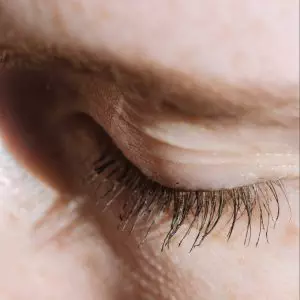
It can be a difficult process being definitely diagnosed with Myasthenia Gravis. Problems with balance, coordination, reflexes, and muscle strength may show up in a neurological exam, but they do not prove definitively what is going on. When the eyelids are drooping, doctors will often perform a test where they ice the area for two minutes to see if this improves the problem. A blood test may show a higher than normal level of antibodies of the type that affect the muscle receptors or proteins. A CT or MRI may reveal a tumor on the thymus.
Other conditions that may appear similar to Myasthenia Gravis include ALS and botulism.
Doctors will prescribe different medications to treat Myasthenia Gravis, either alone, or in combination, depending on the severity and type of symptoms. Corticosteroids and immunosuppressants can reduce the production of antibodies. Plasmapheresis can remove some of the overload of antibodies already in the system. Intravenous immunoglobulin introduces healthy antibodies that can cancel out the malfunctioning ones. Cholinesterase inhibitors can help boost the communication between the nervous system and the muscles. Unfortunately, all of these medications can come with side effects.
Surgical removal of the thymus gland if there is a tumor, or even in some cases when there is no tumor but the gland is believed to be a contributing factor, may help relieve the condition.
Acupuncture and TCM, when used as an adjunct, can help alleviate symptoms of the disorder itself, and help mitigate the side effects of other treatments.
Can TCM Herbs and Acupuncture Help Myasthenia Gravis?
Myasthenia Gravis causes miscommunications between the nervous system and the muscles. Acupuncture treatment can be beneficial for many different types of neurological, musculoskeletal, and autoimmune disorders because it has a positive impact on the communications between the various systems of the body.
TCM treatment with an experienced acupuncturist can be very helpful for patients with Myasthenia Gravis, as we take all aspects of your health into consideration while also focusing on the symptoms related specifically to this autoimmune condition. For example, acupuncture can help with sleep, feelings of anxiety and depression, problems with appetite and digestion, as well as with the muscular weakness associated with Myasthenia Gravis.
One study tested the effects of acupuncture treatment on ocular myasthenia, or eye-related symptoms. Over 90% of the patients treated experience significant improvement in their symptoms.
Chinese herb preparations used in addition to Western conventional medicines can help patients with Myasthenia Gravis. A study compared two groups of patients: one treated with corticosteroids (Prednisone), and one treated with both Prednisone and Chinese herbs. After three months, the patients given herbs showed more improvement, and were able to reduce the amount of corticosteroids needed.
A review of several studies done in China of acupuncture treatment used as complementary treatment for Myasthenia Gravis concluded that patients who had acupuncture reported better clinical outcomes than people who only received the standard pharmaceutical treatments.
While it may be challenging, it is good to include physical activity and even muscular strength training, as it is possible for patients to help overcome muscle weakness with regular exercise. Your TCM practitioner can help you follow an appropriate nutrition and movement program.
Acupuncture Near Me for Myasthenia Gravis in West Los Angeles
TCM is well-suited to help patients who suffer from both autoimmune disorders and neurological and muscular problems of all kinds because it works on multiple levels to help quiet pain signals while boosting communication signals between the different systems of the body. Dr. Tan and Dr. Cai have over 30 years of experience helping people recover from chronic illnesses like Myasthenia Gravis.
*This article is for education from the perspective of Traditional Chinese Medicine only. The education provided by this article is not approved by FDA to diagnose, prevent, treat and cure human diseases. It should not stop you from consulting with your physician for your medical conditions. Traditional Chinese Medicine is based on Qi, which is an invisible force that usually cannot be observed by modern science. Because science focuses on testing ideas about the natural world with evidence obtained through observation, these aspects of acupuncture can’t be studied by science. Therefore acupuncture and Chinese herbs are often not supported by double-blind, randomized trials, and they are considered alternative medicine therapies in the United States.